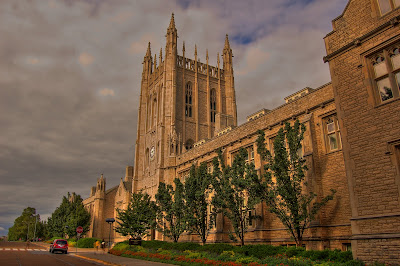Monday, August 31, 2009
A trip around the University of Missouri - Columbia Campus in the early evening...
Mizzou has a ton of things to photograph...
This is Memorial Union. This pic was taken at 4:55pm on a cloudy day. Shot at 18mm f 7.1 @ 1/30 to 1/160
 This is a shot of Jesse Hall from in front of Ellis Library... also taken about 5pm on a cloudy day. HDR really pulls the dark effects out of the sky unless it is masked off in photoshop. Dreary, but cool! 5:10pm Shot at 26mm f 7.1 @ 1/125 to 1/4000
This is a shot of Jesse Hall from in front of Ellis Library... also taken about 5pm on a cloudy day. HDR really pulls the dark effects out of the sky unless it is masked off in photoshop. Dreary, but cool! 5:10pm Shot at 26mm f 7.1 @ 1/125 to 1/4000
Sculpture on Lowry Mall, "Yielding Spire"
Shot at 5:25pm 18mm f 10 @ 1/15 to 1/160
This is Memorial Union. This pic was taken at 4:55pm on a cloudy day. Shot at 18mm f 7.1 @ 1/30 to 1/160
 This is a shot of Jesse Hall from in front of Ellis Library... also taken about 5pm on a cloudy day. HDR really pulls the dark effects out of the sky unless it is masked off in photoshop. Dreary, but cool! 5:10pm Shot at 26mm f 7.1 @ 1/125 to 1/4000
This is a shot of Jesse Hall from in front of Ellis Library... also taken about 5pm on a cloudy day. HDR really pulls the dark effects out of the sky unless it is masked off in photoshop. Dreary, but cool! 5:10pm Shot at 26mm f 7.1 @ 1/125 to 1/4000 Sculpture on Lowry Mall, "Yielding Spire"
Shot at 5:25pm 18mm f 10 @ 1/15 to 1/160
My new thing is HDR photography...
Here is wikipedia's explanation... booooring!
High dynamic range imaging (HDRI or just HDR) is a set of techniques that allow a greater dynamic range of luminances between light and dark areas of a scene than normal digital imaging techniques or photographic prints. This wider dynamic range allows HDR images to more accurately represent the wide range of intensity levels found in real scenes ranging from direct sunlight to faint starlight.
The two main sources of HDR imagery are computer renderings and merging of multiple photographs, which in turn are known as low dynamic range or LDR images. Tone mapping techniques, which reduce overall contrast to facilitate display of HDR images on devices with lower dynamic range, can be applied to produce images with preserved or exaggerated local contrast for artistic effect.
High dynamic range imaging (HDRI or just HDR) is a set of techniques that allow a greater dynamic range of luminances between light and dark areas of a scene than normal digital imaging techniques or photographic prints. This wider dynamic range allows HDR images to more accurately represent the wide range of intensity levels found in real scenes ranging from direct sunlight to faint starlight.
The two main sources of HDR imagery are computer renderings and merging of multiple photographs, which in turn are known as low dynamic range or LDR images. Tone mapping techniques, which reduce overall contrast to facilitate display of HDR images on devices with lower dynamic range, can be applied to produce images with preserved or exaggerated local contrast for artistic effect.









